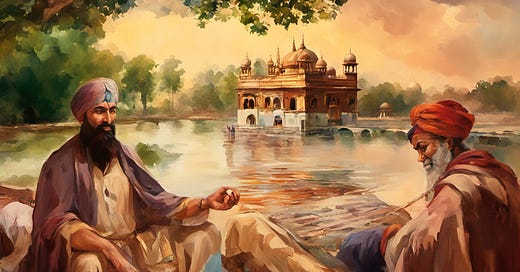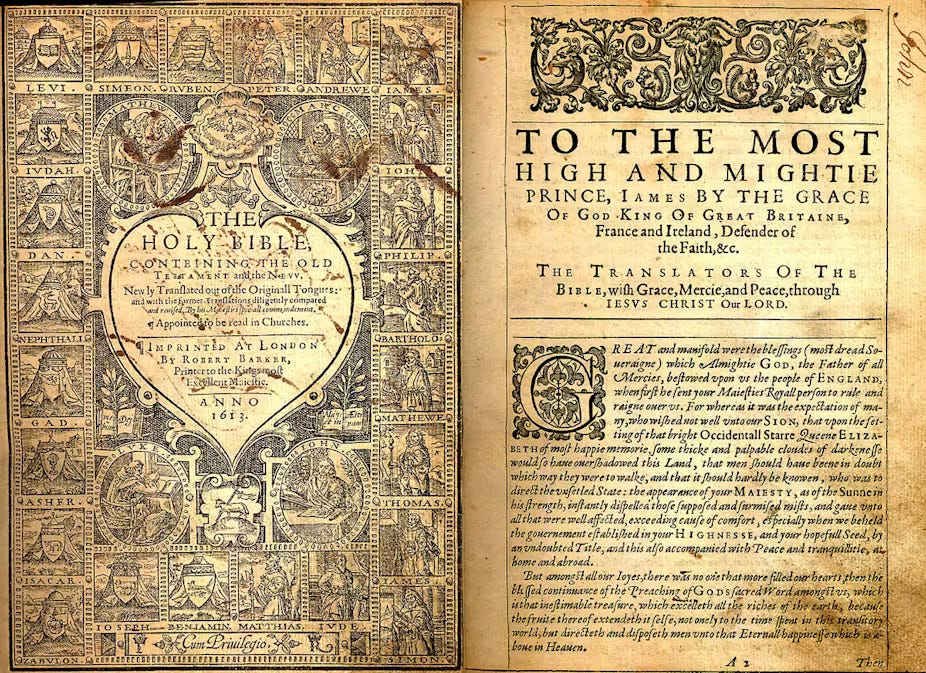The Holy Sikh Scripture of ‘Adi Granth’ Predates the King James Authoritative English Version of the Bible
Enshrined in 1604—The Adi Granth was installed at the Golden Temple Amritsar before King James Bible was completed, and most of its divine verses were revealed prior to Tulsidas Ji’s Ramcharitmanas.

The Adi Granth and the King James Bible — A Relative Chronology
Sikhism is often regarded as one of the more recent among the world’s major religious traditions. Yet, it is important to pause and reflect on a profound and historically undisputed fact: the Adi Granth—the sacred foundational scripture of Sikhism—was meticulously compiled, authenticated, and enshrined in the sanctum of the Harmandir Sahib (Golden Temple) in Amritsar in the year 1604. This solemn event occurred seven years before the publication of the King James Version of the Bible in 1611, which has since become the most influential English-language translation in the Christian world.
This observation is not offered in a spirit of comparison or rivalry, but rather as a respectful reminder of the Sikh Gurus’ extraordinary contribution to the world’s spiritual and literary heritage—an achievement marked by devotion, inclusion, and timeless wisdom.
A Sacred Compilation of Divine Revelation
The Adi Granth, which translates to “The First Book,” was the monumental work of Guru Arjan Dev Ji, the fifth Guru of the Sikhs. He meticulously gathered the hymns of the preceding four Gurus—Guru Nanak Dev Ji, Guru Angad Dev Ji, Guru Amar Das Ji, and Guru Ram Das Ji—along with his own compositions. In a remarkable gesture of spiritual inclusivity, Guru Arjan Dev Ji also included the verses of several enlightened saints from diverse religious backgrounds, irrespective of caste or creed, such as Bhagat Kabir Ji, Bhagat Ravidas Ji, Bhagat Namdev Ji, and Baba Sheikh Farid Ji.
These sacred verses were inscribed in the Gurmukhi script, which had been standardised—if not formally developed—by Guru Angad Dev Ji at Khadoor Sahib during his Guruship (circa 1539–1552 CE). This script, designed for clarity, accessibility, and spiritual expression, became the medium through which the Sikh Gurus' teachings were recorded and preserved.
The task of transcription was entrusted to Bhai Gurdas Ji, a revered Sikh scholar, theologian, and poet. His unmatched command of language, deep understanding of the Gurus’ teachings, and spiritual discipline made him the ideal scribe for such a holy responsibility. Bhai Gurdas Ji’s contribution cannot be overstated—he ensured precision, reverence, and authenticity in transcribing what would become the soul of Sikh spiritual life.
The Installation at Harmandir Sahib
On the historic day of 1st September 1604, the Adi Granth was installed with deep reverence in the sanctum sanctorum of Harmandir Sahib in Amritsar. Guru Arjan Dev Ji did not merely compile the scripture—he bowed before it, solemnly affirming that the Divine Word (Shabad), in addition to the Guru, would henceforth be the eternal guide of the Sikh Panth. This profound act elevated the status of the Adi Granth from a sacred compilation to the spiritual nucleus of the Sikh community. Baba Buddha Ji was appointed the first Granthi, or custodian, symbolising the solemn responsibility of upholding the sanctity, interpretation, and recitation of the holy text.
This momentous occasion laid the foundation for a living spiritual tradition. The Adi Granth was not merely a book; it was—and remains—the foundational composition upon which the Sri Guru Granth Sahib, later ordained by the Tenth Guru, Sri Guru Gobind Singh Ji, was proclaimed as the eternal, living Guru of the Sikhs.
The King James Bible: A Historic Milestone in Its Own Right
In parallel, across continents, King James I of England convened the Hampton Court Conference in 1604, commissioning a new English translation of the Bible. The objective was to unify the religious factions of the Church of England under a single, authoritative scriptural text. The work was entrusted to six committees of scholars and theologians who relied on earlier English versions and Greek and Hebrew manuscripts. The translation was finally completed and published in 1611.
There is no denying the immense cultural and religious impact of the King James Bible. It shaped not only Protestant worship but also English literature and language for generations to come. But what is often missed in global discourse is that by the time this Bible went to print, the Adi Granth had already been compiled, revered, and enthroned as the spiritual nucleus of Sikh life.
Why the Timeline Matters—Not in Rivalry, but in Recognition
Understanding the chronology of sacred scriptures does not diminish one faith while exalting another. Rather, it fosters mutual respect, deeper awareness, and intellectual honesty.
Historical Priority: The Adi Granth was compiled and ceremoniously installed in 1604, while the King James Bible was still in its early stages of planning.
Authenticity and Singular Voice: The Sikh Gurus themselves authored and compiled their teachings, unlike many religious texts that were collated generations later. The Adi Granth is thus a firsthand revelation.
Spiritual Universality: The inclusion of compositions from Hindu bhagats and Muslim fakirs highlights the Sikh Gurus’ embrace of divine wisdom regardless of its source.
Living Scripture: The Adi Granth was later sanctified as the Guru Granth Sahib, the eternal, living Guru of the Sikhs, placing the Word above all temporal leadership.
From Sacred Scripture to the Living Guru: The Evolution of the Adi Granth
The Adi Granth’s journey did not culminate with its compilation in 1604; rather, it marked the genesis of a sacred odyssey that would transform it from a revered scripture into the eternal Guru of the Sikhs. This spiritual metamorphosis reached its zenith in 1706 at Talwandi Sabo (Damdama Sahib), in the present-day Bathinda district of Punjab, where Guru Gobind Singh Ji—after enduring immense personal and political persecution at the hands of the Mughals—dictated a revised and final version of the Granth, known as the Damdama Bir.
With the inclusion of the divine and priceless verses of Guru Tegh Bahadur Ji, the ninth Sikh Guru, especially the soul-stirring Salok Mahala 9, the scripture attained its complete spiritual and immutable form. Notably, Guru Gobind Singh Ji, despite being a towering poet and warrior-saint, refrained from inserting his own compositions—an act of supreme humility that reinforced the Guru’s role as a channel, not the source, of divine wisdom. In a monumental pronouncement at Nanded in 1708, Guru Gobind Singh Ji declared that henceforth, the Guru Granth Sahib would be the eternal and final Guru of the Sikhs. With this act, the Sikh tradition transitioned from personal Guruship to scriptural sovereignty, establishing an everlasting relationship between the community and the Word. Today, every Sikh bows not before a living person but before the Guru Granth Sahib Ji, the embodiment of divine light (Jot) and spiritual authority (Guruship), preserved through the unbroken lineage from the Kartarpur Bir to the Damdama Bir.
Ramcharitmanas and Sikh Scriptures— a Parallel Sacred Timeline
While reflecting on the relative chronology of sacred texts, it may not be out of place to also refer to another revered scripture in the ancient Indian Hindu tradition—the Ramcharitmanas. The original Ramayana, composed in classical Sanskrit and attributed to Maharishi Valmiki, dates back several centuries before Christ (B.C.), and is universally regarded as one of the oldest and most influential epics in world literature. In contrast, the Ramcharitmanas—a poetic retelling of the Ramayana in the Avadhi language—was composed much later by Goswami Tulsidas ji, between 1574 and 1577 CE.
By this time, Guru Nanak Dev Ji had already revealed his divine message, and the sacred compositions of the early Sikh Gurus—Guru Angad Dev Ji and Guru Amar Das Ji—were well established and being lovingly shared within the growing Sikh community.
This respectful timeline comparison highlights that although the Ramayana is an ancient pillar of Indian spiritual thought, the Ramcharitmanas—the version most familiar and beloved across northern India today—emerged during a period when Sikh scripture was already flourishing. It is a testament to the dynamic, evolving tapestry of India’s sacred traditions, where diverse spiritual voices have contributed meaningfully across ages to a shared heritage of devotion, wisdom, and enlightenment.
A Message of Harmony and Shared Heritage
While timelines help us understand the historical unfolding of spiritual traditions, they do not confine the timelessness of Truth. The Adi Granth, formally compiled and enshrined in 1604, predates both the King James Bible (1611) and Tulsidas Ji’s Ramcharitmanas, composed between 1574 and 1577 CE. Guru Nanak Dev Ji’s divine revelations, along with the compositions of Guru Angad Dev Ji and Guru Amar Das Ji, were already flourishing when Ramcharitmanas was being written. And by the time the English-speaking world received its most enduring scriptural translation through the King James Version, the Sikh community had already bowed before the Shabad as their eternal guide.
Yet, chronology does not dictate spiritual stature. Each of these sacred texts—whether the Ramcharitmanas, the King James Bible, or the Adi Granth—offers its own distinct window into the Ultimate Reality. Each brings forth a vision shaped by its own historical context, language, and devotional temperament. They do not compete; they converse across time, testifying to the human longing for the Divine.
In Sikh thought, the Divine is described in the Mool Mantar as:
"Aad Sach, Jugaad Sach, Hai Bhi Sach, Nanak Hosi Bhi Sach"—
True in the beginning, True through all ages, True now, O Nanak, and forever shall be True.
This eternal and Akaal (timeless) Truth transcends all boundaries of chronology, language, or geography. And yet, it is through historical moments—like the enshrinement of the Adi Granth, the composition of the Ramcharitmanas, or the publication of the Bible—that the Infinite makes itself known in finite form.
Recognising this, the Sikh spirit does not seek to elevate one path by lowering another. Rather, it embraces the sacred plurality of revelation while firmly anchoring itself in the Guru’s Shabad as the eternal beacon. Each scripture is a reflection; the Divine is the Light they all reflect.
By Karan Bir Singh Sidhu
Retired IAS Officer, Scholar of Sikh Heritage and Comparative Religions, Former Special Chief Secretary, Government of Punjab
Karan Bir Singh Sidhu is a lifelong student of Sikh scripture, history, and tradition. With a distinguished career in public service and governance, he now devotes his time to interfaith scholarship, historical writing, and promoting deeper understanding of India’s spiritual heritage. His work bridges theological reflection with historical analysis, always grounded in reverence and humility.
The Original Holy Kartarpur Bir Needs to be Preserved by SGPC, not a Private Family
The Sacred Journey of Sikh Scripture: From Kartarpur Bir to Damdama Bir







Thanks, Sidhu Sahab for documenting this chronology. Timeline is one thing, but, looking at the widespread knowledge and acceptability of Ramcharitmanas or Bible, we are way behind. Ramcharitmanas is one Awadhi version of Ramayana, there are several others in Tamil, Bangla, Telugu, Urdu, Malayalam, Punjabi, Oriya - mostly written around same timelines. Same thing about Bible. Point that I'm trying to make is we, as community, have not done enough to spread the message, and have rather restricted it. Our leadership has gone to the extent of equating Sikhi with Islam. By Guru's grace, I have read SGGS 3 times, and am starting next Path soon. My view is that SGGS reflects more of Vedic values and is associated with Indus valley civilization, but we as community have tried everything possible to disassociate ourselves from these. Unfortunate, that such wisdom of 10 Gurus documented over two and a half centuries has not reached over a billion people, just because of insecurity of our leadership. Apologies for any harsh criticism, but intention is to make people aware of what we are, what our values are and what our Gurus said.